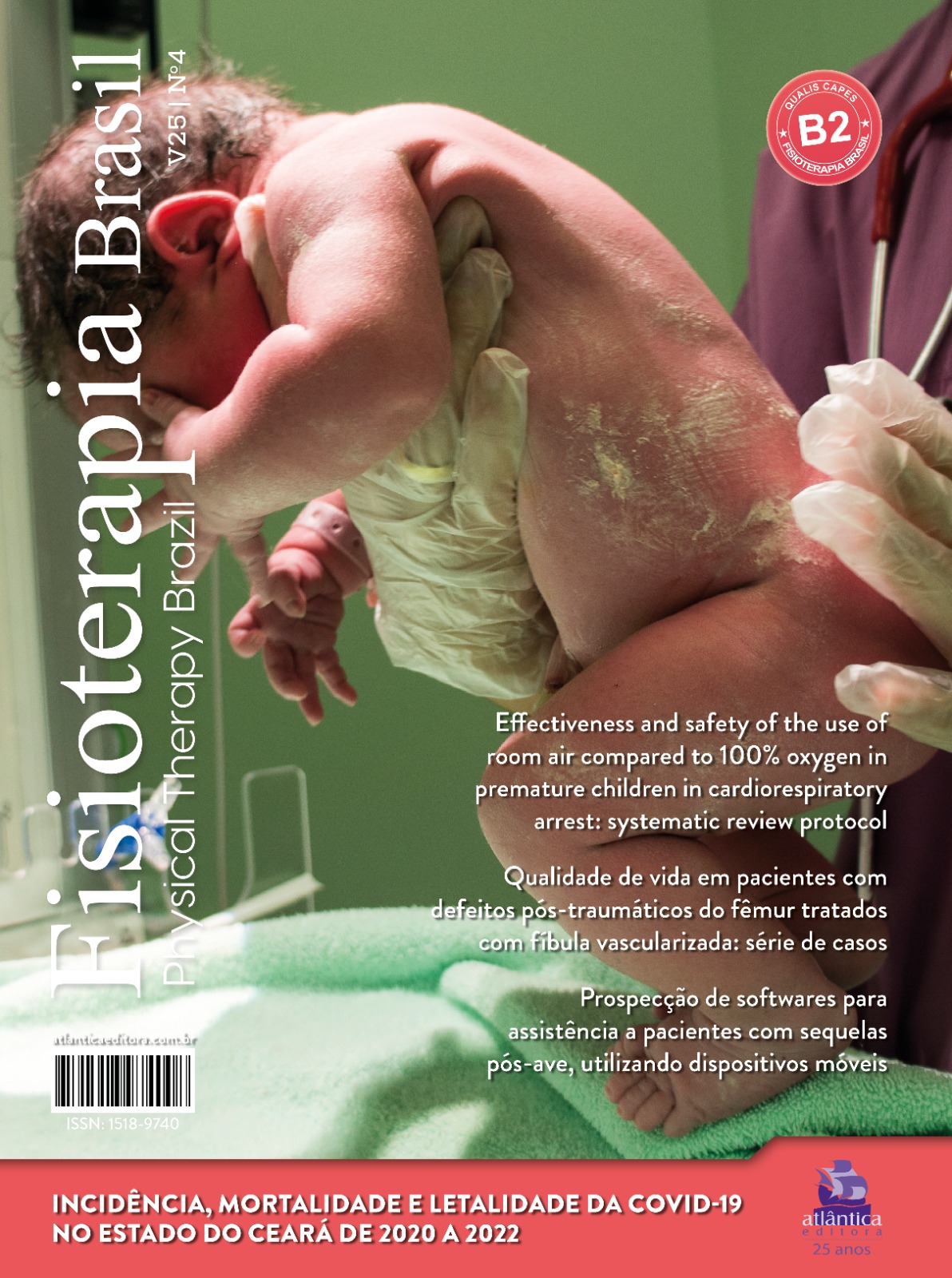Mobile application as an adjunct in adherence to physical therapy treatment of patients with cystic fibrosis
DOI:
https://doi.org/10.62827/fb.v25i4.1017Keywords:
Therapeutic adherence; cystic fibrosis; rehabilitation; smartphone; mobile applications.Abstract
Introduction: Cystic Fibrosis (CF) is the main potentially lethal hereditary disease among Caucasians, presenting systemic complications and the need for a therapeutic regimen that demands time and dedication. Objective: Develop an Application (App) for smartphones that allows guiding and encouraging patients with CF to perform, in a playful and correct way their physiotherapeutic exercises contributing to adherence to home treatment. Methods: Methodological study of technological innovation where the development of the FisioResp App was sought by researchers and an IT professional. Results: 13 users among the list of patients with Cystic Fibrosis registered at the Cystic Fibrosis Outpatient Clinic of the João de Barros Barreto University Hospital consider using the application positive. The Application was designed by the authors based on the Brazilian Recommendation Guide for Physiotherapy in Cystic Fibrosis and was developed by a professional in the area ofInformation Technology, in a private company, being prepared in the Java Script language using the React Native framework for Smartphones with Android operating system and was registered with INPI under number BR512024000738-5. Conclusion: We seek to provide patients and physiotherapists with yet another therapeutic support tool to make their home treatment routine more practical and efficient, by synthesizing and enabling the home prescription of the most commonly used exercises in the outpatient practice of a CF Reference Center. An initial limitation found in the App is the fact that it has been developed, for now, only for the Android platform.
References
Santana NN et al. Percepção da qualidade de vida em crianças com fibrose cística e seus cuidadores: perspectivas diferentes. R. bras. Qual. Vida, Ponta Grossa, v. 10, n. 3, e7587, jul./set. 2018. http://periodicos.utfpr.edu.br/rbqv
Bonfim BS. Avaliação da adesão ao tratamento da fibrose cística entre crianças e adolescentes de um centro de assistência multidisciplinar. 2016. 75f. Monografia de Conclusão de Curso - Universidade Federal da Bahia, Salvador, 2016. Disponível em: https://repositorio.ufba.br/handle/ri/21379
Bento AAC. Adesão ao tratamento com medicações inalatórias em crianças e adolescentes portadores de fibrose cística. 2010. 77f. Dissertação de Mestrado - Universidade Federal de Minas Gerais. Belo Horizonte. 2010. Disponível em: http://hdl.handle.net/1843/BUOS-8LBM52
Santos ALM et al. Cystic fibrosis: clinical phenotypes in children and adolescents. Pediatr Gastroenterol Hepatol Nutr. 2018 October 21(4):306-314. Disponível em: https://doi.org/10.5223/pghn.2018.21.4.306
Feiten TS et al. Fisioterapia respiratória: um problema de crianças e adolescentes com fibrose cística. Jornal Brasileiro de Pneumologia. Brasília-DF 42(1):29-34. 2016. Disponível em http://dx.doi.org/10.1590/S1806-37562016000000068
Beatricci SZ. Adesão ao tratamento antes e após plano educacional em crianças e adolescentes com fibrose cística. 2016. 49f. Dissertação de Mestrado - Universidade Federal Do Rio Grande Do Sul. Porto Alegre, 2016. Disponível em: https://lume.ufrgs.br/handle/10183/151061
Ferreira DP, Chaves CRMM, Costa, AC. Adesão de adolescentes com fibrose cística a terapia de reposição enzimática: fatores associados. Ciência & Saúde Coletiva, 24(12):4717-4726, 2019. DOI: 10.1590/1413-812320182412.31622017
Butcher JL, Nasr SZ. Direct observation of respiratory treatments in cystic fibrosis: parent–child interactions relate to medical regimen adherence. Journal of Pediatric Psychology. 40(1) pp. 8–17, 2015. https://doi.org/10.1093/jpepsy/jsu074
Dalcin PTR et al. Adherence to treatment in patients with cystic fibrosis. Jornal Brasileiro de Pneumologia. Brasília-DF. 33(6):663-670. 2007. https://doi.org/10.1590/s1806-37132007000600009
Athanazio RA et al. Diretrizes brasileiras de diagnóstico e tratamento da fibrose cística. Jornal Brasileiro de Pneumologia. Brasília-DF. 43(3):219-245. 2017. Disponível em http://dx.doi.org/10.1590/S1806-37562017000000065
ASSOBRAFIR Ciência. Recomendação Brasileira De Fisioterapia Na Fibrose Cística: Um Guia De Boas Práticas Clínicas. Maio 2019; v.10(supl 1): 189p. Disponível em: http://portalgbefc.org.br/ckfinder/userfiles/files/Recomenda%C3%A7%C3%A3o%20Brasileira%20de%20Fisioterapia%20na%20Fibrose%20C%C3%ADstica.pdf
Gruber W, Orestein DM, Braumann KM. Do responses to exercise training in cystic fibrosis depend on initial fitness level? European Respiratory Journal. 2011; 38: 1336–1342. https://doi.org/10.1183/09031936.00192510
Romanelli BB, Castro MRAA, Spinola IP. (Organizadores). Cartilha: Fibrose cística para pacientes e seus cuidadores. Belo Horizonte: Núcleo De Ações E Pesquisa Em Apoio Diagnóstico-Nupad/ Fm/Ufmg, 2015. 56p. Elaborada Por Maria Piedade F. Ribeiro Leite. Disponível em: https://www.nupad.medicina.ufmg.br/wp-content/uploads/2016/12/Cartilha-Fibrose-Cistica_1ed.pdf
Hebestreit H et al. Long-term effects of a partially supervised conditioning programme in cystic fibrosis. European Respiratory Journal. 2010; 35: 578–583. https://doi.org/10.1183/09031936.00062409
Klijin PHC et al. Effects of anaerobic training in children with cystic fibrosis: A randomized controlled study. Chest. April, 2004. 125:1299–1305. https://doi.org/10.1378/chest.125.4.1299
Moorcroft AJ, Dodd ME, Morris J, Webb AK. Individualised unsupervised exercise training in adults with cystic fibrosis: a 1 year randomised controlled trial. Thorax. 2004; 59:1074–1080. https://doi.org/10.1136/thx.2003.015313
Moreira WEM et al. Aplicativo móvel: intervenções fisioterapêuticas à idosos frágeis. Fisioter Pesqui. 2021;28(2):220-229. https://doi.org/10.1590/1809-2950/21002128022021
Cingi C et al. The physician on call patient engagement trial (POPET): measuring the impact of a mobile patient engagement Application on health outcomes and quality of life in allergic rhinitis and asthma patients. Int Forum Allergy & Rhinology. 2015 Jun;5(6): 487-97. https://doi.org/10.1002/alr.21468
Marques ADB et al. PEDCARE: validação de um aplicativo móvel sobre o autocuidado com o pé diabético. Rev Bras Enferm. 2021;74(Suppl 5): e20200856. doi: https://doi.org/10.1590/0034-7167-2020-0856
Downloads
Published
Issue
Section
License
Copyright (c) 2024 Renato da Costa Teixeira, Erisandra do Socorro Pereira de Freitas, Luiz Carlos Soares de Carvalho Junior (Autor)

This work is licensed under a Creative Commons Attribution 4.0 International License.
Autores que publicam nesta revista concordam com os seguintes termos:
Autores mantém os direitos autorais e concedem à revista o direito de primeira publicação, com o trabalho simultaneamente licenciado sob a Licença Creative Commons Attribution 4.0 que permite o compartilhamento do trabalho com reconhecimento da autoria e publicação inicial nesta revista.
Autores têm autorização para distribuição não-exclusiva da versão do trabalho publicada nesta revista (ex.: publicar em repositório institucional ou como capítulo de livro), com reconhecimento de autoria e publicação inicial nesta revista.



